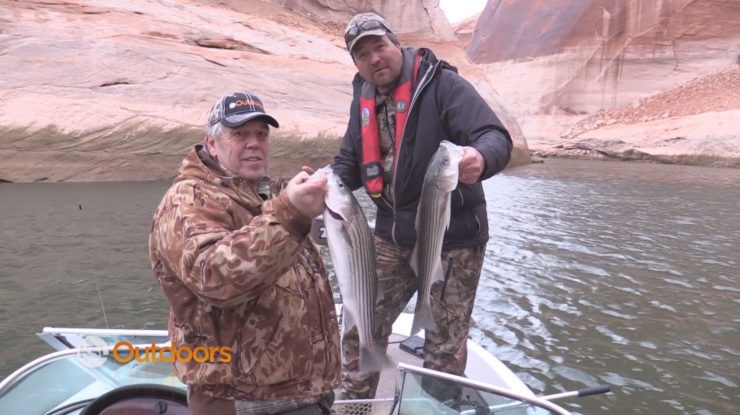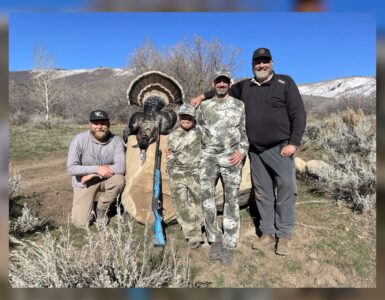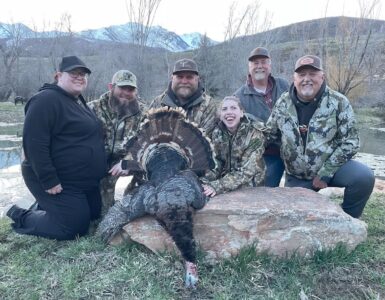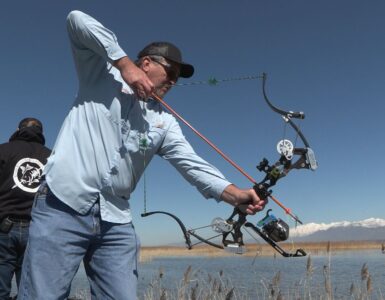Thanks for tuning into KSL Outdoors, I’m Adam Eakle. Well it is January, we’ve got one of these big storms that has rolled in. So what do you do? Well we decided to load up the boat and head to Lake Powell where it’s a little warmer. We’ve got a bunch of friends that do this every year. They invite us so, we thought we’d take you along with us this year. We are here in Spanish Fork Canyon and it is white knuckle going over the top. But the weather down at Powell is supposed to be about 50 degrees, can’t wait to get there.
Most anglers don’t think of Lake Powell as a winter fishing destination. If you’ve never ben here though, believe me, you are missing out.
There he is! Nice hit, man he just slammed it.
The fishing can be downright amazing, not to mention the spectacular scenery. That’s something that a group of firemen from the Wasatch Front figured out clear back in 1981 and they’ve been coming here every January, ever since.
Little striper thumb.
It is surprising to me that more people aren’t down here in the wintertime. It’s just not within their comfort zone. A lot of people would rather be skiing or recuperating from the holidays as being down here catching fish. But I think it’s because people haven’t had the experience.
Well let’s mess some fish up boys. Go kick some butt. Absolutely.
We made it! A little wet! The wind was blowing pretty good out in the bay so we decided to come into the back of a canyon. I think what we’ll do is we’ll start trolling, trying to locate some of these striper schools. Dan I always use a Wally Diver. Ok. Start with a Wally Diver and maybe I’ll start with a Shad Rap and, you know, troll around, find the schools, once we find them, then we can jig them up maybe.
You said about 100 feet out? Yeah I’d say about a 100.
Oh yeah we are marking fish at 30.
How are we going to catch stripers on these poles. Oh I got a fish. What do you mean how? Well it says walleye on here. Oh walleye. So I just don’t know.
Little striper.
This is why I brought Adam along with me. He takes care of my fish for me.
Well there is striper back here. What do you think? Fillet able. He’s not bad. We’ll throw him in there.
He’ll make a turd.
We are finding fish.
Oh yeah more fish, marking lots.
In twenty to thirty feet of water, in the back of the canyons.
There’s a fish.
It came to the surface. I’m guessing it’s a walleye.
Little walleye. We’ll take that huh? Nice fillet.
Alright we’ve got striper, we’ve got walleye. There’s fish in the back of canyons. Maybe we’ll get out the jigs, some night crawlers, some anchovies, get some more fish.
See what kind of damage we can do here.
Oh there we go! Woo! I’m going to get out of your way! You’d better.
Oh good striper! Yeah that’s a nice fish and see the one following him. There was another one following him. Yeah I saw that.
In the wintertime in January. How about that. It’s hard to handle.
There we go.
Our group caught stripers, walleye, catfish, and even a few bass using jigging spoons, anchovies and curly tailed grubs in the back of these canyons.
There’s a fish.
We noticed however that some of the stripers, about a third.
Longer but skinnier.
Were not in good shape.
There’s a fish. Oh threw over there and…That is funny. Oh he’s a fighter.
Yeah that’s a good fish. Healthy one. Best one I’ve caught.
Oh look at the one following him. Put it right there in front of him.
Yeah right there somewhere. There he is, double. There’s our double. You’re getting this right? There’s our double. We can leave.
There we go. Nice. Hey, That’s the way to clean up huh? We can go home, now we’ve got to go and fillet. I think so. I mean you’ve got to go fillet. That’s alright brother. Oh those are good fish too. They are.
Double to end it there tonight. Fun. Yeah, good day today. We had a great time. We caught some walleye, caught some strippers, some skinny ones, some big fat ones. These ones aren’t bad, they’ll fillet up nice. Not too bad at all. Hey you Idaho boys you can fish a little bit. Thanks for the lesson. Yeah.
We’ve awoke to just a beautiful morning for fishing. It’s cold, about 30 degrees, but just a slight breeze.
The anticipation of the day ahead has our crew eager to get on some fish.
Alright we found them. Out here in Bullfrog. The whole screen is literally covered. We’ve got to get on them.
There he is. Nice hit, I like that. Hey for winter, middle of January huh Dan? How about this? Snowy lake Powell. Yeah boy. Catching stripper. This is hard to handle. Oh man more people need to come out here and do this. This is a lot of fun. Nice fish to, he’s got some shoulders to him.
There we go. Welcome aboard buddy.
Get him? Yup. Nice.
Yeah they are just a little healthier over here for some reason. Must be a little more food.
There’s one, oh, he about ripped it out of my hand. So what they are doing is we are getting these jigs down there. And they uh… We get right to the bottom and once you get to the bottom, you are pulling them up a couple of cranks and you are just jigging it off the bottom and they usually hitting it on the way down. So you don’t necessarily always feel the bite. It’s when you go to jig and you feel weight or like that one, about rip it out of your hands. Then you know you’ve got a fish.
There we go.
Oh right there! There he is. Nice.
Oh he’s pulling good. These are so much fun. It’s just, people that aren’t out doing this are missing the boat.
Oh there he is. Doubles. Got a double. Triple Brad is on the front to. Alright now we are talking. That’s pretty good fishing there.
Can’t beat that! Look at that, fish coming overboard.
You know its best before you put these things in the live well to go ahead and take a pair of sheers and cut their throat and bleed them out. It makes a lot better eating fish.
The bite in Bullfrog is nonstop from sunrise to mid-morning. Anchovies will work, but the best technique is jigging a spoon within a foot of the bottom. My buddy Brad.
Figured out the technique and is catching two to three fish for everyone I catch. Brad, Rex, Dan, Ron and some of the others aren’t firemen, but they’ve been coming down with these guys for nearly two decades. It’s fun to just sit back and listen to their stories.
It was so much fun and just being down here with the same group of guys. You dog! Take that off and I’ll catch another.
We had a feeling this morning, didn’t we? We did, we called it. This isn’t a giant, but we’ve caught some nice fish, some nice fillets. A lot of fun down here at Lake Powell. Get down here, bring your family, bring your buddies and come catch a boat load, no limit of stripers.
. Hopefully we’ve inspired you to come down and try Powell in the winter. If we have. Here’s a run down of our gear.
So there is a lot of lures, techniques that you can use to come down and catch stripers. Probably the easiest is just come down and troll.
It allows you to locate them, once you locate them, then you can start jigging for them. I have a few favorites here, some that I’ve gotten from Wayne Gustaveson the biologists here at Lake Powell, other from my buddies Ryan Mosley who is a fantastic fisherman. Who has shown me some of these great lures. I think the wally diver is probably my most favorite and probably most producing lure. Troll it you know 3 miles per hour and it’s getting down 8-10 feet. Depending on how much line you let out.
The Shad Rap, in fact this shad rap in purple has been my favorite. I don’t know if you can see that but it’s got a translucent, kind of a holographic look.
So once you find them, you want to jig for them right. What do you use to catch them with a jig. Kastmaster will work. I would get different varieties, different sizes, different colors.
This Cordell, Cotton Cordell is another good jigging spoon, Wayne Gustaveson recommends that one. This is another one that I picked up at Sportsman’s, I’ve never tried it, it worked.
The Double Header, but that would be, it’s a little lighter, probably work best in 30-40 feet of water. Obviously you saw we did better fishing when there was less wind. Because we could keep our lines going straight down below the boat. I personally like to use braid too, so when you use braid there’s no stretch so when you hit the fish, you are going to get a good hook set.
My buddy Brad says you’ve got to have 5,6,7 feet of fluorocarbon tippet on your braid, you get that braid and it enables you to get a good hook set, a good hook into the fish and the fluorocarbon, of course they can’t see it.
There we go.
Another good way to come down here, especially with kids and you can catch a lot of striper is with anchovies. Cut them into thirds, I like to use the head and the tails, I think they stay on pretty good, but my buddy Brad who caught most of the fish today. He likes to use the middle portion, I usually chum with that, but he says there is a lot of oils in that middle portion of the anchovies.
He uses a 3/8th ounce jig head, a little heavier. It gets you down there faster, it enables you to keep that line down straight down and just fish that real close to the bottom.
It just doesn’t matter what you throw down there Adam. They are hitting everything.
That’s a pretty good haul. Great haul.
We are going to take home just from these fish, probably 5 pounds of fillets. Absolutely, can’t wait. My mouth is already watering.
















Add comment